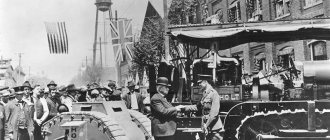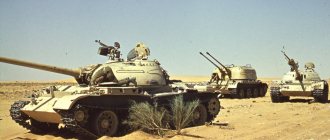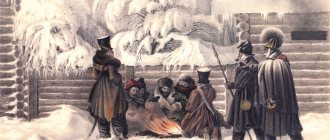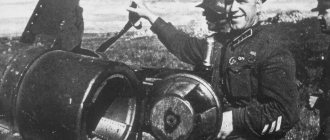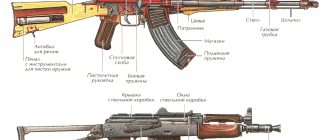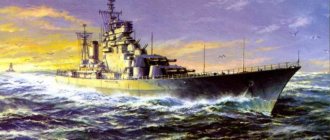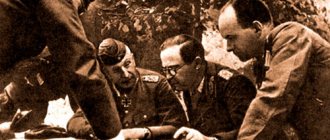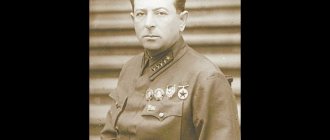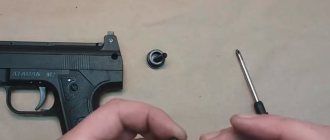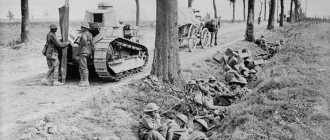Squad
The beginning of the counter-offensive of the 20th Army against the Nazi strike force turned out to be quite sluggish. To turn the situation around, they put together a small detachment from the 31st Tank Brigade, consisting of one KV tank, three T-34s and one BT with a landing force from an infantry company. These were the cars that the whole country saw. KV, T-34 and BT tanks of the 31st Tank Brigade walked along Red Square on November 7, 1941, forever remaining in the chronicles. The brigade was also commanded by the future commander of the tank army, Andrei Kravchenko.
Parade on November 7, 1941 (photo source)
The tankers decided to reach the Leningrad highway in one rush and cut off the Germans’ escape route. The window of opportunity for this was provided by the still “loose” front.
The breakthrough on the afternoon of December 10 was a resounding success. The detachment wedged itself between the retreating columns. He forestalled the battalion of the German 67th regiment in the village of Kochergino and rushed further behind him.
Panic quickly spread in the retreating Nazi columns.
Just three tanks that burst into the next village, Khmelevo, forced the Germans to flee from it further to the west, to Karpovo. The headquarters of the 67th Wehrmacht Regiment was located there, and its commander, Colonel Reichert, tried unsuccessfully to exhort his fleeing subordinates. And soon he himself joined them.
Already at dusk, Soviet tanks reached the Leningrad highway and took up defensive positions along with the landing force. The path of the advance detachment of the Kravchenko brigade became literally the road of death for the Germans. The tank crews’ report contains an eloquent phrase: “the enemy left dozens of corpses on the road.” The losses of the brigade itself can be assessed as insignificant: three killed and five wounded, two tanks exploded.
It was all in vain
Then the Germans tried to take advantage of the thick fogs and snowfalls, which added surprise to their attacks. The combination of all their cunning and tank power allowed them to move forward and even encircle individual units.
But this could not change the main fact - the offensive was stuck in the Soviet defense. And the Germans did not achieve their goal - the release of Budapest. By March 15, enemy troops were finally convinced of the failure of Operation Spring Awakening and went on the defensive.
The losses were serious: almost 300 tanks burned down, hundreds were in long-term repairs. The last large mobile formation, which a month ago could have been transferred somewhere, the 6th SS Panzer Army, no longer poses a serious threat.
Hungary remained with the Red Army. And the path to Berlin, not protected by maneuver formations, was now open.
German self-propelled gun Jagdpanzer IV/70 was hit in an ambush (waralbum.ru)
German self-propelled gun Jagdpanzer IV/70 was hit in an ambush (waralbum.ru)
White ghosts
The ghost tanks belonged to the 8th Tank Brigade of Pavel Rotmistrov, the future commander of the Guards Tank Army. They trivially bypassed the mines and other obstacles placed by the Germans using previously scouted routes. No mysticism.
However, the sudden appearance of a strong tank fist out of nowhere came as a shock to the flank barrier of the 3rd Panzer Group. The Germans wavered and ran, leaving their guns and vehicles.
The unexpected blow forced the German command to urgently begin to retreat from Moscow, so as not to end up in a “bag” with communications cut off.
Soviet troops on the march pass through the liberated city of Klin (photo source)
Rotmistrov's tankers first broke through to the highway from Klin to the north, then to the Volokolamsk highway. Thus, they intercepted the enemy’s supply and escape routes. In five days, the tankers collected three hundred German trucks as trophies, despite the fact that the main prize went to the “queen of the fields” - the infantry - on the roads east of Klin. It was there that enemy trucks, cars, tractors and tanks left without fuel were abandoned.
Expert commentary
Evgeniy Belash, military-historical publicist, author of the books “Tanks of the Interwar Period” and “Myths of the First World War,” as well as articles on historical topics for the Warspot and Warhead portals.
Evgeniy Belash, military-historical publicist, author of the books “Tanks of the Interwar Period” and “Myths of the First World War,” as well as articles on historical topics for the Warspot and Warhead portals.
To fight fascist tanks, anti-aircraft guns, tanks, self-propelled guns, conventional guns were grouped in advance... The result was a huge barrier of more than four thousand guns with a caliber of 45 to 152 mm. The guns were collected in special anti-tank areas - in the places where the Germans were most likely to attack. The batteries were camouflaged.
Some of the guns were supposed to “flirt” with enemy tanks, diverting their attention to themselves and exposing them to fire from hidden batteries. This tactic was justified back in Spain in the 1930s and at Khalkhin Gol.
The Su-100 self-propelled guns were good, but they had one drawback. The Germans attacked not only with tanks, but also with infantry. The crews of the self-propelled guns, who did not have machine guns, had to fight back with whatever they had to. Based on the results of the battle, the Su-100 was called the most effective means of combating enemy heavy tanks. But a machine gun for self-defense would still not hurt.
- Five myths and the whole truth about the legendary Katyusha - here.
The last tank battle of the great war: ambushes and camouflage
